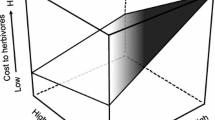Abstract
We reared larvae of three generalist insect species on plants occurring in their habitats. Individuals of each species were kept either on mixed diets, or on each plant species separately. We measured food plant preference in the mixed-diet group and compared insect performance on single plants to the performance on the mixed diet. For all three insect species, food choice within the mixed-diet groups was non-random and delivered the best overall performance, thus fulfilling the criteria for self-selected diets. When a single diet was as good as the mixed diet for one particular aspect of performance (Adenostyles alliariae and Petasites albus for Miramella alpina; A. alliariae for Callimorpha dominula), it was never the most preferred food plant in the mixed-diet treatment. Whether the benefit achieved by mixing diets is due to nutrient complementation or toxin dilution, we argue that there is no easy way to distinguish between the two hypotheses on the basis of consumption and performance measurements, as has previously been proposed. From the interpretation of utilisation plots, the ANCOVA equivalent of nutritional indices, we were able to gain insight into where in the sequence from ingestion to growth (preingestive, predigestive or postdigestive) single diets caused differences from mixed diets. The elements of this control system which were influenced by single diets varied considerably, both within and between insect species. No food plant was toxic or deterrent to all experimental insect species; a food plant that caused consumption effects (preingestive) for one insect species could be dealt with metabolically (postdigestive) by another; different food plants could cause behavioural effects (preingestive), metabolic effects (postdigestive), or a combination of both effects, all within the same insect species. However, one generality did emerge: once a food was ingested, further growth-relevant effects occurred metabolically (postdigestive) rather than via differential egestion (digestibility).
Similar content being viewed by others
Author information
Authors and Affiliations
Additional information
Received: 5 October 1998 / Accepted: 1 March 1999
Rights and permissions
About this article
Cite this article
Hägele, B., Rowell-Rahier, M. Dietary mixing in three generalist herbivores: nutrient complementation or toxin dilution?. Oecologia 119, 521–533 (1999). https://doi.org/10.1007/s004420050815
Issue Date:
DOI: https://doi.org/10.1007/s004420050815




